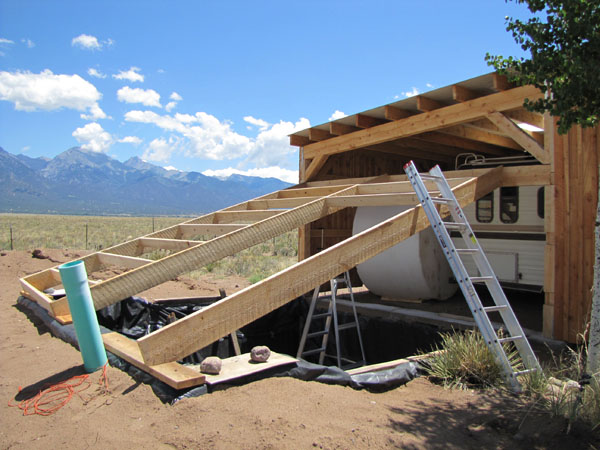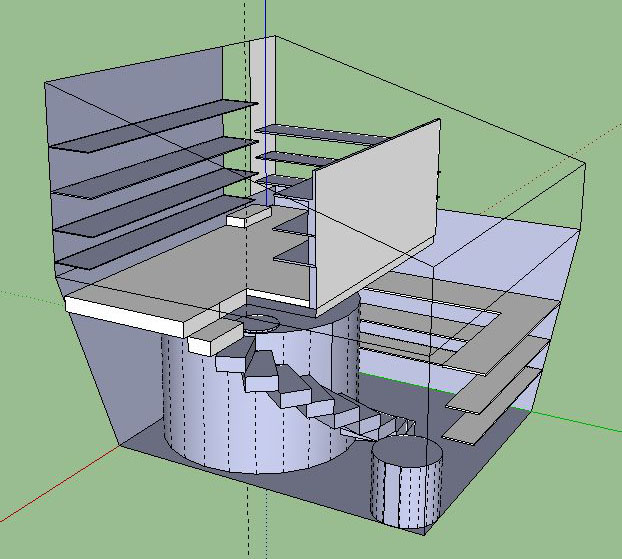This is what the pantry looks like today. I have finished all of the bag work and am now building the framework for the roof. The large turquoise pipe in the foreground is the inlet air vent that goes all the way down to the bottom of the hole with an elbow through the bag wall. In the distance, next to the motor home, is a 1500 gallon water tank that I got a great deal on. That tank will be dropped into the pantry hole for storage of rain water off the roof of the garage. The vertical walls that will meet the roof of the pantry will be cordwood construction, providing good insulation to keep the panty temperate; the roof will be well insulated as well.
The concept that I came up with for how to utilize the space in the pantry is pictured above. There would be two levels, so that it would be just a short step down into the upper level, which would be over the water tank. A spiral stair case would circle around the water tank down to the lower level. This concept provides considerable area for shelves, as you can see. The little cylinder in the corner is there to demonstrate that there would be room for a little table down there as well. I believe that with the substantial underground construction and the large water storage inside, that the space will never freeze in the winter, even though our temperatures will often go below zero degrees F. This pantry is on the north side of the garage, so it shouldn’t heat up much in the summer either. It will be a nice place to go and get cool on hot days.



the idea of pandering to LOCAL Codes or building RESTRICTIONS, should NEVER even come in to play at all especially if one is a FREEMAN [OR WOMAN] ON THE LAND!! why even APPLY for PERMITS etc. etc. when LOCAL COUNCIL HAS NO STANDING AT ALL. the WHOLE GOVERNMENT SYSTEM IS FAKE and SLAVE MASTERS.
dagyboy raises an important point.
I’ve been extremely vocal in the comments of this blog disputing the wisdom, effectiveness, and appropriateness of building codes.
At the same time, I’ve never suggested that the solution is to break the law.
It is all too easy to get caught into that trap. I urge caution and calm reflection for anyone considering heading down the path of ignoring or intentionally violating building codes. It is a path full of dangers and potholes. It leads to a life where one is constantly looking over one’s shoulder wondering who might be the person that could report them to the authorities. It leads to a life of fear. It leads to a life of distrust of everyone.
That’s not freedom. That’s not life. That is imprisoning oneself!
The path to freedom is to seek areas with few or no building codes. Find an area where it is legal to build what you want, the way you want to build it. Then you’ll enjoy what you have built and not live in constant fear that someone will someday come knocking on your door wanting to force you out of that which you have built for yourself.
You’ll be free to live. You’ll be free to have friends and share the accomplishments of your efforts with them. You’ll be free of the stress and fear of losing your home.
That’s a freedom worth working for.
If you don’t like a law, you don’t have to choose to break it. You can choose to move to a place that has laws more to your liking, or you can choose to try to work locally to change the law.
The first option is the path to slavery. The second two options are the path to freedom.
I won’t pretend to try to TELL anyone which path to take. However, I choose the path of maximum freedom. I choose to seek areas with few or no building codes, AND to do what I can to help to change the laws for the better.
It sure feels better than trying to hide my work under a rock and cower in constant fear of being discovered.
Thanks for the responce. I tried looking for the blog on places with few or no building codes and couldn’t find it. Do you know if anywhere in MA has little to few building codes? That’s where my wife is from and where she wants to live. I did find online that there was a strawbale house built but I’m sure it was probably not a cheap one as it was under a lot of codes. And land itself is not cheap by any means out here.
Highly populated areas usually have the strictest codes. I doubt if there are any counties with few or no codes. Talk to a local architect to find out. Building to code can raise the price 5x-10x.
Clever, thanks for posting Kelly.
I like the multipurpose aspects. Start with a small, simple home and then add on multipurpose spaces when affordable.
Nice. That much water should stabilize the temps nicely. Do you know what the rainfall temp is in the summer? It should cold enough to “recharge” the fridge in the summer.
My only concern is how to prevent flooding from overfilling the tank. Do you have a valve/overflow system in mind?
Our rainiest months are July and August, but the rain is likely fairly cool. In fact at 8,000 ft. in the mountains we sometimes get hail during these months. I haven’t decided how to prevent overfilling, but I can imagine making a simple floating ball valve that would stop this from happening.
First of all I want to say this new barn and pantry look great. Secondly I have a question but not sure where to ask. If you build an insulated earth bag home or strawbale home where building regulations require some form of post and beam or wood frame structure is it still possible to build it low cost?
A post and beam frame will increase the cost. You’ll have to do a detailed cost estimate to determine exact costs. The cost of post and beam is greatly reduced if you use recycled wood, poles from a local forest, or wood from local sawmills. However, codes in most areas don’t allow this. It’s for “your safety”, don’t you know? Har har. So that’s why we’re always talking about finding remote rural areas with few or no codes. See our blog post Counties With Few or No Building Codes.